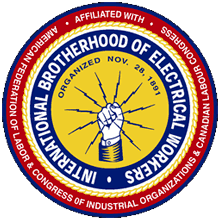June 11, 2013
By Joe Maniscalco

New York, NY – On April 9, 2008, Christopher Gunn was a 28-year-old ironworker with Local 40 doing the job he loved best and looking forward to new life as a married man, when a beam he was helping to install at a job site near Bellevue Hospital broke loose and sent him plunging 25 feet below onto his head. Now, the law that has helped the Gunn family finally welcome Chris home after five long years of intense rehabilitation, is in danger of being repealed.
“He was an incredible kid,” John Gunn, Sr. says of his son. “Always active, always teasing – always laughing. He was always a go-getter from when he was a little boy. I remember him wanting to be around people, wanting to do things and learn. He learned like a sponge. He always wanted to be the best at what he did – and he was that. Unfortunately, somebody pulled the rug out from under him.”
The fall that Chris suffered left him with a severed spinal cord and severe brain injuries. According to doctors, he will never walk again, and is now susceptible to 17 different risk factors that could prematurely end his life.
John Gunn, Sr. has spent the last five years at his son’s side – rarely seeing the rest of his family – as Chris endured excruciating surgeries and endless rounds of intensive physical, drug and occupational therapy at medical facilities located around the country.
Chris spent the last two years at a rehabilitation center in Greenfield, New Hampshire, and is finally coming back home to his remaining family in New Jersey to continue his uncertain journey of recovery. All of this has been possible because current New York State law governing scaffolding snafu’s like that one that cost Chris so much, holds employers and contractors wholly responsible for the ensuing damages if it can be shown that there was negligence on their part.
“I don’t know why this is even issue,” John Gunn, Sr. says. “As a father, it is the most ridiculous thing I have heard of in the past five years since Chris got hurt. If there was no law to protect Christopher, he would be in a nursing home right now with a tube up his rear end and one down his throat.”
New York State’s existing scaffolding law has roots going all the way back to 1885. But the protections it has traditionally offered have steadily become an anomaly across the nation. Cost-conscious insurance companies, business groups and construction companies largely based Upstate, are pushing hard to see that New York is no longer the last holdout.
Worker advocates fear that two anti-labor bills in the New York State Legislature being backed by State Senator Patrick M. Gallivan and Assemblyman Joe Morelle, now have a good chance of actually passing and turning back the clock a hundred years.
“Employers are trying to shift the liability and the cost of their irresponsible actions onto workers,” says Joel Shufro, executive director of the New York Committee for Occupational Safety and Health [NYCOSH]. “We know that at this point and time, there is tremendous pressure on employers to do work quickly and cut corners – they make profits over those sorts of things. We say that workers shouldn’t have to suffer as a result of that.”
Lawyers for the Gunn family contend that had the employer insisted on easily installed safety lines, Chris Gunn could have avoided his catastrophic injuries.
From 2009 to 2011, there were 102 construction worker deaths in New York State, according to NYCOSH. In 2011, over 700 construction workers died nationwide. NYCOSH spokesperson Nick Rizzo says that being a roofer is twice as dangerous as being a cop.
“The scaffold law is a worker safety law that saves lives and focuses on protecting workers on the most dangerous jobs,” says Michael Jaffe, president of the New York State Trial Lawyers Association. “If contractors and owners follow this safety law, they save lives. It’s that simple.”
As it stands now, many cases involving construction site falls never go to trial because employers are presently more likely to agree to a settlement. In addition to saving lives, critics of those trying to repeal, or water down existing scafolding legislation, charge that overturning the protections will result in a flood of costly new trials.
John Gunn, Sr. says he fully understands the cost factors involved for employers, but that it’s workers like his son Chris who ultimately pay too high a price.
“At the end of the day, it’s the worker that suffers,” he says. “And it’s because of unsafe conditions. And it’s because of contractors taking shortcuts, not spending the money they need to spend, not caring about their workers – just caring about getting a job done – that makes these accidents happen.”



